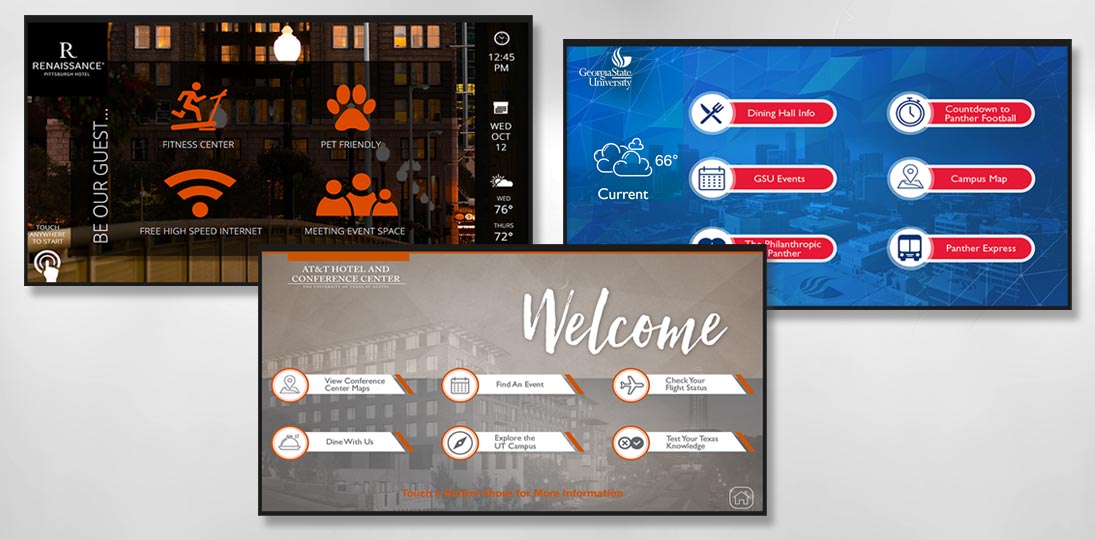Digital signage is a great tool in helping create a more consumer-like experience for people who visit your facility. This means presenting information and options in a way that is similar to how people normally access data in their lives. Today that means accessing the web through apps on smartphones, tablet and computers – very often on touchscreens. When people first enter your building, mimic their browsing habits and make them self-sufficient by offering a virtual concierge.
Think of staying in a hotel, especially as a business traveler. The concierge is an invaluable resource, able to answer questions, make reservations and procure products and services tailored to your specific needs. If they don’t know the answer to your question immediately, they’ll do the research and find what you need. Other types of facilities have something similar – clinics and hospitals have a front desk, corporate hubs and campuses have an info desk in their lobby, government offices might have a receptionist, schools have a front office, etc. But often times, the people manning those stations have other duties to perform, and their time is a bottom-line expense that is precious to the organization.
Instead, you can leverage your digital signage to offer the same services, without taking time away from staff or costing the organization an additional salary. People are already used to navigating websites and apps to find information they need, so just extend those capabilities to the digital signs you’re already using.
This is obviously easier with interactive screens and kiosks, especially web-connected displays. An astonishing amount of information can be nested in a logical, easy-to-navigate interface that allows them find what they need quickly. This is your “virtual concierge” or “digital concierge”.
And unlike in a hotel, where the requests could be just about anything (scheduling a taxi, buying theatre tickets, making dinner reservations, finding a nearby tailor), the number of things people might want when they enter your facility is likely much more streamlined. There are there with a specific purpose, which makes it easier for you to figure out what they might need, and make that information available on your screens.
They’ll probably want to know where things are in the building, so wayfinding is a good starting place. Interactive maps and highlighted travel routes, paired with a comprehensive directory (divided into sortable sections, like name, department, task or function), can relieve stress and make it much easier for your visitors to get around efficiently.
What else might people want or need when they come to your facility? Think about everything you can, and then make that available on your screens. If you have a queueing system, add that to your digital signs. While it’s certainly possible to have several displays in an area, each with a different purpose (this one is wayfinding, that one is for the queuing system, another one shows on-site amenities), it’s actually better to have all that information available at each screen. That way, your visitors can pick and choose what they want, and the experience becomes more personalized. (Just make sure you have enough kiosks on hand to prevent long wait times to use them.)
While people are getting what they need, they’re also being exposed to your other content – mission statements, promotional messages and anything else you want to tell them. And your digital concierge can pull information from data sources for real-time updates to event schedules, daily menus for on-site refreshments, countdowns to deadlines and more – all to the same screen. Your brand is also being promoted at the same time, since you’re showing your logo, colors and imagery. You can even include surveys and information on loyalty programs to further promote your brand.
A virtual concierge also helps break down language barriers. For example, if you’re located in an area with a lot of Spanish, Tagalog and Vietnamese speakers, simply having buttons on your screens that change the interface and information language is a lot faster and less expensive than making sure you always have staff working who speak those languages. It’s also a great way to provide service to those with hearing disabilities.
Sometimes it might be best to have interactive kiosks that deal with the most common requests, and still have staff on hand to handle more specialized or unusual needs. This allows an additional degree of personalization that customers appreciate. You should also consider extending your concierge outside your venue with a downloadable app. This extends the visitor experience and lets you continue to engage your audience beyond your facility.
If you can’t employ touchscreens, you can extend the idea of a virtual concierge to your static displays by applying the same thought processes for your content. What do people need when they arrive at that particular digital sign? Make sure the most common answers to viewers’ questions are repeated frequently. The top five solutions should show at least every 60 seconds, so plan your playlists accordingly.
Whatever displays you choose, creating a virtual concierge system will vastly improve the visitor experience. Make sure it’s fast, efficient and information-rich, and that navigation is clean and intuitive, and your audience will thank you for a great visitor experience.
